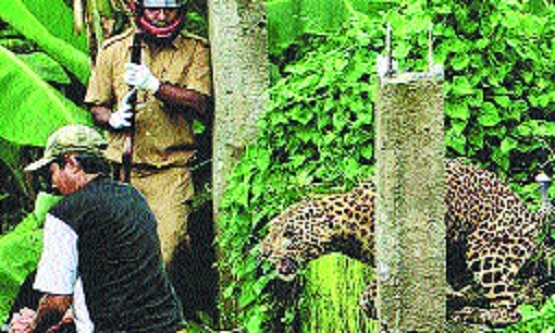Man-animal conflict, territorial fights on the rise in State: Data
| Date :21-Feb-2022 |

Staff Reporter :
Several recent incidents of wild animals entering various villages and cities are clear enough indications of increase in man-animal conflict. The official statistics for the past three years confirm this phenomenon. The data for the years 2019, 2020, and 2021 also point out that territorial fights between wild animals are on the rise. City-based activist Abhay Kolarkar had sought details regarding human casualties and injuries in wildlife attack for the abovesaid three years. In response, the office of Principal Chief Conservator of Forest (Wildlife), made available the official data. The data reveals that the number of deaths of humans in wildlife attacks are increasing. In 2019, 47 human beings lost their life in attack by wildlife.
The next year, most of which saw lockdown and strict restrictions on movement of people in the wake of COVID-19 outbreak, the number of human casualties in wildlife attacks rose to 80. In 2021, the number increased further to 84. Thus, the number has been rising steadily. There is another dimension to the story. The casualties of wild animals in territorial fights have also been rising.
As far as tiger deaths in territorial fights are concerned, the year 2019 witnessed only one such death as per the official records. It was reported in Chandrapur district. The next year, however, saw five tiger deaths in territorial fights. Three of these were reported in East Nagpur Circle, one each in Melghat Tiger Reserve and Gadchiroli district. In 2021, the number increased further to six deaths of which four were in area under East Nagpur Circle, one each in Chandrapur district and Melghat Tiger Reserve. Forest Department has compiled data of deaths of wild animals in territorial fights, for tiger, leopard, black buck, deer, bison, and sloth bear. Like in case of tigers, there has been steady rise in number of leopard deaths in territorial fights. If 2019 saw 16 leopard deaths, the year 2020 saw 17 deaths, followed by 21 in 2021. Out of total 54 deaths of leopards in these three years, maximum 25 died in Nashik Circle, followed by 11 in Pune Circle, and 10 in Chandrapur Circle.
Though this is the situation, there is a silver lining to the story -- the number of persons injured in wildlife attacks has come down. As per the financial year-wise data, 412 persons were injured in wildlife attacks in 2019-20. The number came down to 400 in 2020-21. There was a big drop in number in 2021-22, which saw 67 persons injured in wildlife attacks. There has been steady decline in number of livestock killed and injured in these three years. In 2019-20, wild animals killed 9,258 livestock and injured 93. The details for next two years are as follows: 2020-21 -- 9,139 killed and 155 injured, 2021-22 -- 3,213 killed and 33 injured. As per the norms, compensation was paid to the affected families, as follows: 2019-20 -- Rs 70 crore, 2020-21 -- Rs 80 crore, 2021-22 -- Rs 59.36 crore.
‘Increase in population of tigers & leopards, shrinking of habitat behind phenomenon’
The data points at spilling over of population of wild animals, particularly of tiger and leopards in respective geographical areas. Already, in case of Chandrapur district which has Tadoba-Andhari Tiger Reserve, several quarters have expressed concern over increase in man-animal conflict involving especially tiger and leopard. In the recent days this year, human deaths in area near Chandrapur Super Thermal Power Station have raised concern among locals. Prof Suresh Chopane, Member, Regional Empowered Committee, Ministry of Environment and Forest and Climate Change, told ‘The Hitavada’ that the issue had several dimensions. “The man-animal conflict previously restricted to forest areas is being seen recently in Chandrapur city too. Some people have lost their lives. In some cases, even the wild animals lost life.
The situation has changed in the past 10 years. Now, the population of tiger and leopard has increased tremendously. But, their habitat has shrunk, movement corridors are broken, human encroachment and movement in forest have increased,” he explained. According to him, due to coal mines and thermal power station around especially Chandrapur, tiger and leopard are able to easily find prey in dogs and pigs. The forested area around thermal power station and coal mines has become a sort of tiger habitat. If Chandrapur Super Thermal Power Station, Western Coalfields Limited, and Forest Department join hands and offer some fundamental solutions, the man-animal conflict may be mitigated to an extent, Chopane suggested. Also, he said that people also should reduce visiting forested areas. It may be recalled here that a few months ago, similar concern prevailed among residents of area near Brahmapuri, Nagbhid, Sindewahi over presence of tiger and man-animal conflict.
In fact, there was a talk about shifting the excess population of tigers to other parts of the State and country where tiger population had come down. However, under the pressure of environmentalists and wildlife lovers, it could not materialise. With increase in population of tiger and leopard, experts had predicted, the number of incidents of man-animal conflict are bound to increase. The latest data obtained by Abhay Kolarkar just confirms the trend.